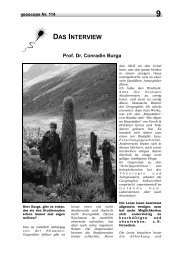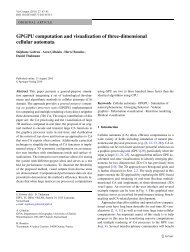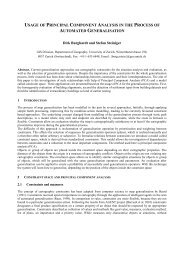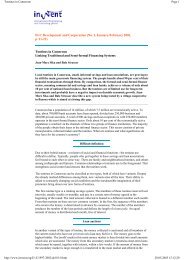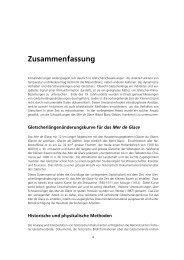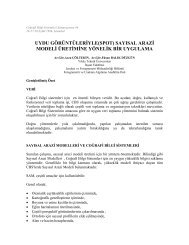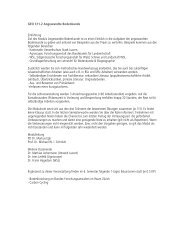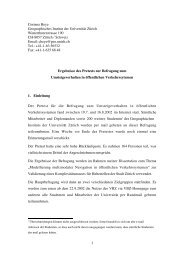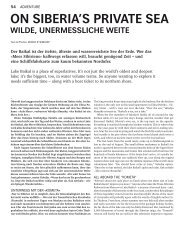KYRGYZSTAN TODAY Policy briefs on - Department of Geography
KYRGYZSTAN TODAY Policy briefs on - Department of Geography
KYRGYZSTAN TODAY Policy briefs on - Department of Geography
Create successful ePaper yourself
Turn your PDF publications into a flip-book with our unique Google optimized e-Paper software.
seemingly happen to form regi<strong>on</strong>ally or are c<strong>on</strong>centrated in the country’s capital city,<br />
yet, there are attempts to work together and <strong>on</strong>ly 9 percent <strong>of</strong> NGOs reported not having<br />
joint activities (though the survey focused <strong>on</strong> 2005 – an unusually dynamic year in terms<br />
<strong>of</strong> collective acti<strong>on</strong>s because <strong>of</strong> the March 2005 post-revoluti<strong>on</strong>ary movements).<br />
Since the late 1990s coaliti<strong>on</strong>s and networks have formed as a way for NGOs<br />
to work together. Being part <strong>of</strong> a network or associati<strong>on</strong> is becoming fashi<strong>on</strong>able<br />
and productive (<strong>on</strong>ly 9 percent reported that participati<strong>on</strong> in associati<strong>on</strong>s/coaliti<strong>on</strong>s<br />
was <strong>of</strong> no use, while the rest stated that it helped to get to know each other, to<br />
spread informati<strong>on</strong> and increase outreach and to organize joint events). Going<br />
bey<strong>on</strong>d collecting names <strong>on</strong> an associati<strong>on</strong>’s list and moving towards regular<br />
members’ participati<strong>on</strong> in real social activities is still an issue for many associati<strong>on</strong>s<br />
and coaliti<strong>on</strong>s, although at the moment even tertiary and symbolic c<strong>on</strong>nectedness is<br />
important, though not sufficient.<br />
Theoretically, more than five hundred currently active organizati<strong>on</strong>s could have<br />
come up with numerous ways <strong>of</strong> being c<strong>on</strong>nected and forming more diverse associati<strong>on</strong>s.<br />
There are new areas <strong>of</strong> public interest, which become the juncture for new c<strong>on</strong>necti<strong>on</strong>s,<br />
such as gold mining, which has brought together envir<strong>on</strong>mental and human rights<br />
organizati<strong>on</strong>s. However, there are areas, like public televisi<strong>on</strong> reform, which were high<br />
<strong>on</strong> the rhetorical agenda, but have not translated into collective acti<strong>on</strong>, apart from a<br />
handful organizati<strong>on</strong>s specifically specializing in the issue. Links between the emerging<br />
experts/think tanks community and the NGO sector is <strong>on</strong>ly now being forged and is<br />
happening at too slow a pace for current civil society’s policy activities.<br />
Civil society as an associati<strong>on</strong>al society?<br />
NGOs in Kyrgyzstan quite <strong>of</strong>ten serve as a place for individual acti<strong>on</strong>s <strong>of</strong> individuals<br />
working there and who come together with a relatively small number <strong>of</strong> other individuals<br />
in other organizati<strong>on</strong>s. There are <strong>of</strong> course examples when NGO leaders come together<br />
quickly to sign petiti<strong>on</strong>s or put together advocacy campaigns <strong>on</strong> electi<strong>on</strong> m<strong>on</strong>itoring.<br />
The most notable example was in 2002 when women’s NGOs gathered more than 30<br />
thousand signatures to introduce a popular legislative initiative regarding domestic<br />
violence. Few examples highlight the general trend <strong>of</strong> n<strong>on</strong>-sustained associati<strong>on</strong>al<br />
membership. It would be great from the social capital perspective if even a small number<br />
<strong>of</strong> those who signed the anti-domestic violence legislative initiative remained active and<br />
regularly engaged members for women’s causes.<br />
In times <strong>of</strong> crisis, a country produces social movements as a way for citizens to<br />
express their support for or the undesirability <strong>of</strong> social change in a sustained and l<strong>on</strong>gterm<br />
manner. Occasi<strong>on</strong>al blasts <strong>of</strong> dissent and protests have been part <strong>of</strong> NGOs’ history,<br />
though in rare cases they can be called movements. The low level <strong>of</strong> trust between<br />
organizati<strong>on</strong>s, and them and their c<strong>on</strong>stituencies, is another factor hindering the<br />
development <strong>of</strong> wider collective acti<strong>on</strong>s.<br />
Sector and wider society<br />
Members <strong>of</strong> NGOs are members <strong>of</strong> society and quite <strong>of</strong>ten their pers<strong>on</strong>al stories <strong>of</strong><br />
unhappiness with social reality led them into public activities. However, attachment to<br />
the cultural settings <strong>of</strong> either their previous background or their current envir<strong>on</strong>ment<br />
has an impact <strong>on</strong> their activities as members <strong>of</strong> civil society. Divides are created by<br />
language, city/rural sub-cultures, generati<strong>on</strong>al differences and many other factors, and<br />
15






